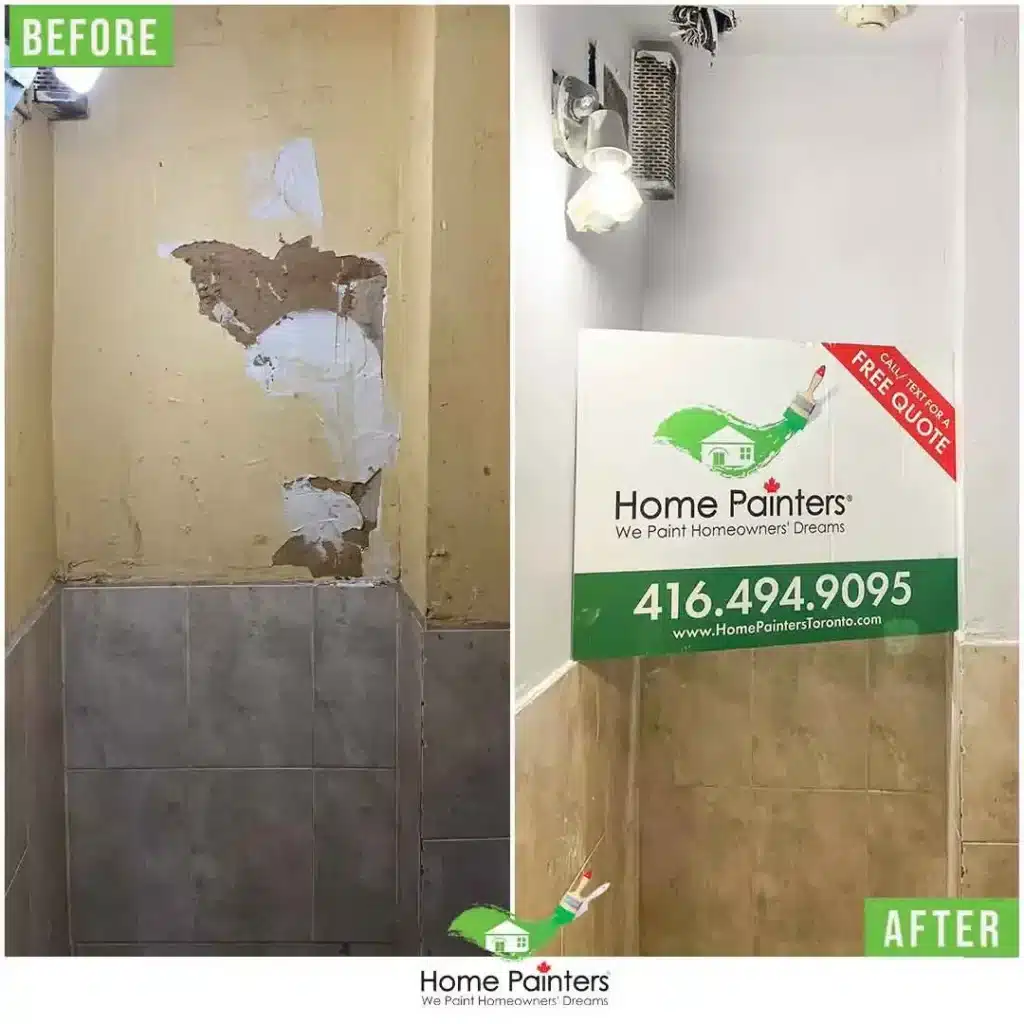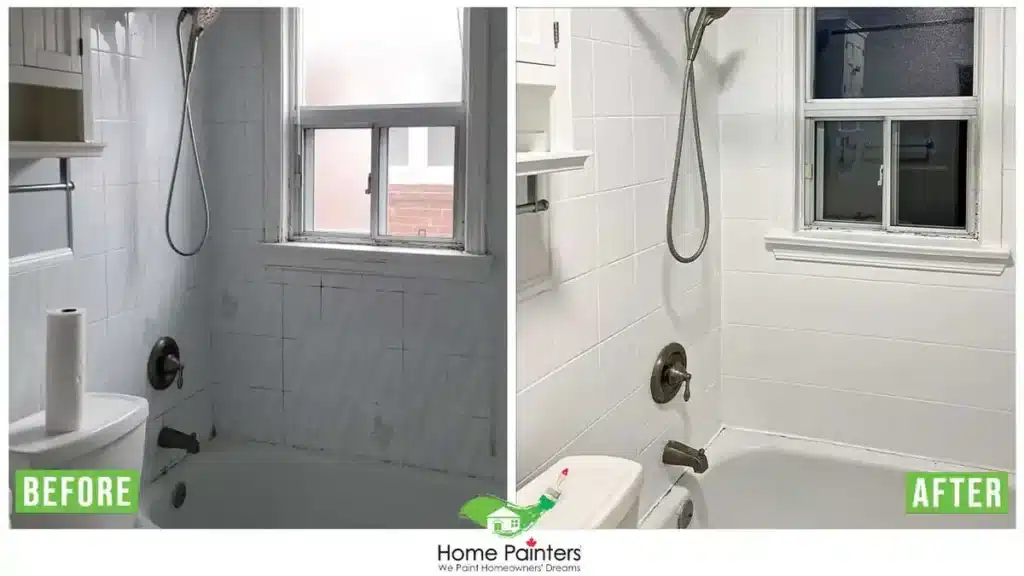
How To Fix Bathroom Ceiling Paint Peeling

What Are the Causes of Bathroom Ceiling Paint Peeling?
- Peeling or bubbles happen when you start painting in high humidity.
- It can also occur when the paint is applied over built-up water and soap scum. Usually around the things you use every day like the shower, sink and toilet.
- Another simple mistake that causes bathroom ceiling paint to peel is just improper cleaning, prep and priming.
- It can often be that painful extra step for people to paint their ceilings. So, it’s really no wonder that individuals often rush through that step in the painting process.
- Also, another culprit is not allowing enough time in between coats for adequate drying. This severe cracking found on ceilings is actually called ”alligatoring”.
- It’s really important to give your coats of paint, especially in the bathroom, adequate time to fully dry.
Enough about the issues though as we’re here to discuss solutions!
Here is an ideal guide on how to fix bathroom ceiling paint peeling!
Before you even get started on fixing your bathroom ceiling paint peeling, you have to think about prevention. Bathrooms can be such a breeding ground for mould and mildew. It’s not just the fact that they’re usually smaller spaces. But it’s the water and humidity that comes from daily showers and baths. The key to preventing ceiling paint from peeling in the first place is good ventilation. It’s crucial to have a good fan in your bathroom and even better if it has a timer to keep it on for at least an hour after you bathe. Also, it’s a great thing to have a window open in your bathroom as well. Especially after you’ve hit the shower, it just helps to keep the air circulating, which is exactly what you want to prevent that paint from peeling.
How to Stop Bathroom Ceiling Paint Peeling
If you’ve already got the peeling paint problem, there are a few steps you can take to stop it from getting worse.
- First, make sure that you have good ventilation in your bathroom. If not, start by installing a fan if one isn’t already there. Then try opening up a window for about an hour after bathing. This will help lower the humidity levels and prevent further damage from occurring.
- Cleaning out any dust or dirt that may have accumulated over time is important. Then you can use an anti-mildew solution in order to keep mould from growing back on the walls and ceiling.
- Try caulking around the edges of the room. This will help keep moisture from creeping in and causing problems with the paint.
- Another thing that may work is applying a layer of plaster over the top of your current paint job. This will help seal the walls and make them more resistant to moisture.
There are a few things that you’re going to need in order to make the process of repairing bathroom ceiling paint peeling go smoothly. Here is your list:
- Paint scraper
- Putty knife
- Protective goggles and a dust mask
- Fine grain sandpaper
- Vacuum sander (if available)
- Sheetrock plaster
- Paintbrush & paint roller
- Paint tray
- Bathroom primer
- Specialty bathroom interior paint

Step 1: Scrape Off the Peeling or Chipped Paint
- Before you begin any of your work, be sure all areas are dry. This goes for the ceilings as well as the walls. Don’t use the shower a day or two prior to repair.
- Begin to remove peeling paint with a putty knife. This will make the surface uneven, but that’s okay for now.
- Make sure you wear protective eye gear and a dust mask. This prevents dust particles from getting into your eyes or your lungs, which can be very dangerous.
- Use fine-grain sandpaper to sand the area where you removed the paint blisters. Brush off any dust.
- Be sure to remove flaking paint in all areas. The only paint left on the wall should be firmly stuck to the wall!
Step 2: Patch Where Bathroom Ceiling Paint Peeling Had Been
When the chipped paint or paint bubbles are removed, the surface will be uneven. Some areas will have a layer of paint whereas others won’t.
- Use a patching compound to even out the bathroom walls and the ceiling.
- This will be a skim coat of sheet rock plaster. You can find it at any hardware store. Sheetrock CGC 20 should do the job.
- Apply it in a thin layer, using a putty knife for this process. You want to let this coat completely dry for at least six hours time. Even better, if you have a few full days to work with, give it a whole day to dry.
- When the first coat is fully dry, you can sand it smooth.
Step 3: Apply a second coat of sheetrock plaster, if needed & Sand again
- You might be able to get away with just one coat of sheetrock plaster.
- If you do need two coats to properly repair your peeling paint, be sure to let the ceiling area dry for at least six hours between coats. After you have waited the appropriate amount of time, you can apply another thin layer of sheetrock plaster with a putty knife.
- After your second application is sufficiently dry, sand it down again with fine sandpaper. Be sure to put on your protective goggles and mask again!
- Sanding after this coat of sheetrock plaster will ensure there are absolutely no uneven edges and it’s all smooth.
- You can always use a vacuum sander for the ceiling instead of sandpaper. This is to avoid dust dropping directly on you. This helps to further protect your eyes and your lungs.
Step 4: Prime the Bathroom Wall prior to painting
- Now that everything is all repaired, smooth and sanded, it’s time to think about priming and painting!
- Usually, bathroom walls start peeling because they weren’t properly primed in the first place. Primer is the first defence against water and moisture! Allow it to be your best friend, especially in bathroom areas.
- If you want to go for a quality primer from Benjamin Moore, our expert recommendation is the latex-based Fresh Start Primer. This primer works well in bathrooms because it’s mildew resistant, quick drying and has great adhesion. All criteria you want to be ticked off for bathroom ceiling paint!
- If you want to go with Sherwin Williams, we recommend their Multi-Purpose Latex Primer.
- Prime the area you have prepared with a brush or small roller.
- It’s best to give the primer at least one full day to dry before you put on your finishing coat of paint.
Step 5: Paint your Bathroom!
When the primer is completely dry, it’s time to paint. So, what is the best paint to use on a bathroom ceiling? Below are our top picks for the best paint for bathroom ceilings.
- Choose a paint that has a gloss or semi-gloss finish. These paints don’t absorb moisture as other paints do. They also won’t peel or flake over normal bathroom use. A higher-gloss eggshell might also work, but don’t go any lower than that.
- If you’re looking for a flat finish, check out the Benjamin Moore Aura Bathroom Walls & Spa Matte. It’s a little more expensive, but it will give your bathroom that sharp finish that flat paints usually provide.
- If you are looking to go with Sherwin Williams Duration Home Interior Acrylic Latex is recommended in a satin finish.
- With these paints, you can usually do a second coat, if needed, once the first coat has had time to dry.
How to Repair Peeling Paint on Textured Ceiling
If you have textured ceilings, the easiest way to repair peeling paint is with a ceiling texture spray. You can find these at any hardware store, and they are very easy to use. All you need to do is clean off any loose paint or dust from your ceilings, then spray on the texture spray in 3-4 foot sections until it covers all of your textured walls.
You’ll want to make sure that you use a light touch when applying the ceiling texture spray. Otherwise, it could look like you have too much paint on your walls. Once you have applied the texture spray and let it dry completely (about 30 minutes), then you can paint over it using any colour of your choice.
More interesting blogs related to
“How To Fix Peeling Paint On Your Bathroom Ceiling Or Wall”
Are you unsure if you can handle this job yourself? It sounds like you might need some professional painters to do the hard work for you. Home Painters Toronto has over 36 years of painting and home renovation experience. If you’re having trouble with bathroom ceiling paint peeling, call 416.494.9095 or email [email protected] for a FREE quote or visit our website. And don’t forget to follow us on all our social channels below as well!





